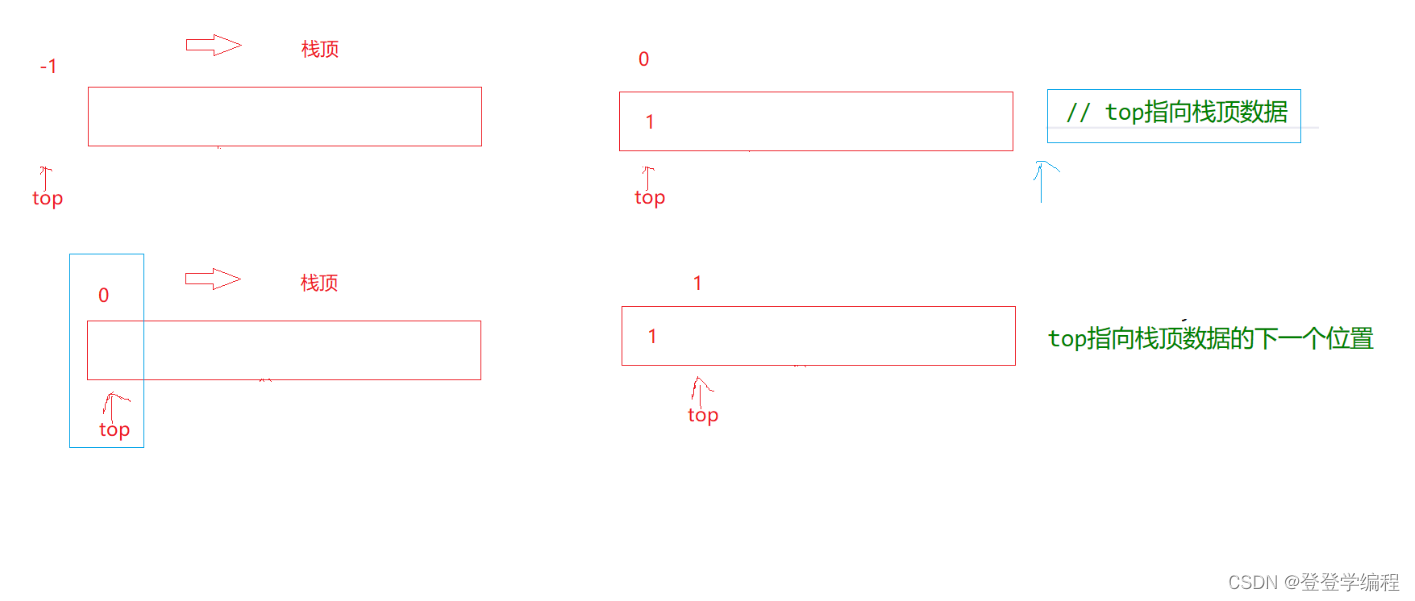一,栈的概念及结构
栈:一种特殊的线性表,其只允许在固定的一端进行插入和删除元素操作。
进行数据插入和删除操作的一端 称为栈顶,另一端称为栈底。
栈中的数据元素遵守后进先出LIFO(Last In First Out)的原则。
压栈:栈的插入操作叫做进栈/压栈/入栈,入数据在栈顶。
出栈:栈的删除操作叫做出栈。出数据也在栈顶。

预想用数组,单链表,双向链表都可以实现

首先排除双向链表----------->节省空间,少一个指针方便维护
数组更优-------------------->cpu高速缓存
二,栈的实现
首先创立test.c Stack.c Stack.h三个头文件
Stack.h 实现函数的声明
Stack.c 实现栈的主要逻辑
test.c 测试代码可行性
1,栈的定义
typedef int STDataType;
typedef struct Stack
{
STDataType* a;
int top;
int capacity;
}ST;2,栈的初始化
void STInit(ST* pst);
void STInit(ST* pst)
{
assert(pst);
pst->a = NULL;
// top指向栈顶数据的下一个位置
pst->top = 0;
// top指向栈顶数据
//pst->top = -1;
pst->capacity = 0;
}top初始化可分为两种:0或-1
我们选择0

3,栈的销毁
void STDestroy(ST* pst);
void STDestroy(ST* pst)
{
assert(pst);
free(pst->a);
pst->a = NULL;
pst->top = pst->capacity = 0;
}4,栈的入栈
void STPush(ST* pst, STDataType x);
void STPush(ST* pst, STDataType x)
{
assert(pst);
// 扩容
if (pst->top == pst->capacity)
{
int newcapacity = pst->capacity == 0 ? 4 : pst->capacity * 2;
STDataType* tmp = (STDataType*)realloc(pst->a, newcapacity * sizeof(STDataType));
if (tmp == NULL)
{
perror("realloc fail");
return;
}
pst->a = tmp;
pst->capacity = newcapacity;
}
pst->a[pst->top] = x;
pst->top++;
}5,栈的出栈
void STPop(ST* pst);7
void STPop(ST* pst)
{
assert(pst);
assert(pst->top > 0);
pst->top--;
}6,取栈顶数据
STDataType STTop(ST* pst);
STDataType STTop(ST* pst)
{
assert(pst);
assert(pst->top > 0);
return pst->a[pst->top - 1];
}7,栈的判空
bool STEmpty(ST* pst);
bool STEmpty(ST* pst)
{
assert(pst);
return pst->top == 0;
}
8,获取数据个数
int STSize(ST* pst);
int STSize(ST* pst)
{
assert(pst);
return pst->top;
}三,总代码预览
Stack.h
#pragma once
#include<stdio.h>
#include<stdlib.h>
#include<stdbool.h>
#include<assert.h>
typedef int STDataType;
typedef struct Stack
{
STDataType* a;
int top;
int capacity;
}ST;
// 初始化和销毁
void STInit(ST* pst);
void STDestroy(ST* pst);
// 入栈 出栈
void STPush(ST* pst, STDataType x);
void STPop(ST* pst);
// 取栈顶数据
STDataType STTop(ST* pst);
// 判空
bool STEmpty(ST* pst);
// 获取数据个数
int STSize(ST* pst);Stack.c
#include"Stack.h"
// 初始化和销毁
void STInit(ST* pst)
{
assert(pst);
pst->a = NULL;
// top指向栈顶数据的下一个位置
pst->top = 0;
// top指向栈顶数据
//pst->top = -1;
pst->capacity = 0;
}
void STDestroy(ST* pst)
{
assert(pst);
free(pst->a);
pst->a = NULL;
pst->top = pst->capacity = 0;
}
// 入栈 出栈
void STPush(ST* pst, STDataType x)
{
assert(pst);
// 扩容
if (pst->top == pst->capacity)
{
int newcapacity = pst->capacity == 0 ? 4 : pst->capacity * 2;
STDataType* tmp = (STDataType*)realloc(pst->a, newcapacity * sizeof(STDataType));
if (tmp == NULL)
{
perror("realloc fail");
return;
}
pst->a = tmp;
pst->capacity = newcapacity;
}
pst->a[pst->top] = x;
pst->top++;
}
void STPop(ST* pst)
{
assert(pst);
assert(pst->top > 0);
pst->top--;
}
// 20:08继续
// 取栈顶数据
STDataType STTop(ST* pst)
{
assert(pst);
assert(pst->top > 0);
return pst->a[pst->top - 1];
}
// 判空
bool STEmpty(ST* pst)
{
assert(pst);
return pst->top == 0;
}
// 获取数据个数
int STSize(ST* pst)
{
assert(pst);
return pst->top;
}test.c
#include<stdio.h>
#include<stdlib.h>
//
//int main()
//{
// // 原地扩容
// // 异地扩容
// int* p1 = (int*)malloc(8);
// printf("%p\n", p1);
//
// int* p2 = (int*)realloc(p1, 80);
// printf("%p\n", p2);
//
// free(p2);
//
//
// int i = 0;
// int ret1 = ++i;
//
// int ret2 = i++;
//
//
//
// return 0;
//}
#include"Stack.h"
//int main()
//{
// ST s;
// STInit(&s);
// STPush(&s, 1);
// STPush(&s, 2);
// STPush(&s, 3);
// STPush(&s, 4);
//
// printf("%d\n", STTop(&s));
// STPop(&s);
// printf("%d\n", STTop(&s));
// STPop(&s);
// STPop(&s);
// STPop(&s);
// STPop(&s);
//
// //printf("%d\n", STTop(&s));
//
// STDestroy(&s);
//
// return 0;
//}
int main()
{
// 入栈:1 2 3 4
// 出栈:4 3 2 1 / 2 4 3 1
ST s;
STInit(&s);
STPush(&s, 1);
STPush(&s, 2);
printf("%d ", STTop(&s));
STPop(&s);
STPush(&s, 3);
STPush(&s, 4);
while (!STEmpty(&s))
{
printf("%d ", STTop(&s));
STPop(&s);
}
STDestroy(&s);
}






















 562
562

 被折叠的 条评论
为什么被折叠?
被折叠的 条评论
为什么被折叠?








